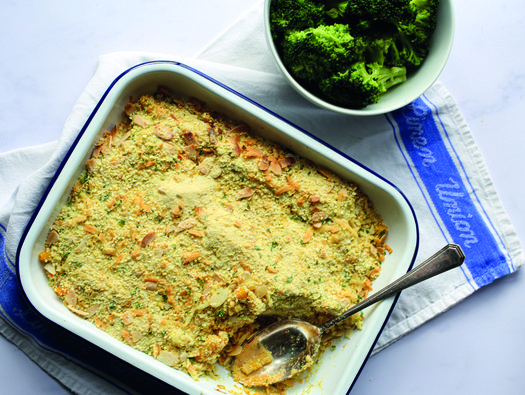Baked macaro-no-cheese

Using butternut squash for the creamy sauce, this delicious vegan dish is low salt, low potassium, low phosphate, and low protein, so it is suitable for everyone.

Using butternut squash for the creamy sauce, this delicious vegan dish is low salt, low potassium, low phosphate, and low protein, so it is suitable for everyone.
1 butternut squash (approximately 600g)
175ml full fat coconut milk
2 teaspoons Dijon mustard
1 low salt vegetable stock cube
1 teaspoon cider vinegar
250g macaroni pasta
Black pepper
100g breadcrumbs
50g vegan grated cheese
30g flaked almonds
1 tablespoon fresh parsley (optional)
200g broccoli
Preheat the oven to 160°C / 140°C fan / gas mark 3. Halve and deseed the butternut squash. Place flesh side down in a roasting tin and pour in 200ml water. Bake in the oven for 1 hour and 30 minutes.
Allow the squash to cool slightly before scooping out the flesh with a spoon. Add to a blender with the coconut milk to make a smooth puree.
Once pureed, heat gently in a saucepan. Add Dijon mustard, cider vinegar and crumble in stock cube. Season with pepper and add a little water to the sauce if needed. Simmer for 20 minutes until it thickens
Bring a large pan of water to boil. Add the macaroni and cook for 7 minutes. It will continue to cook as it bakes. Drain the pasta and combine with the sauce, pouring them in to an oven proof dish.
Combine the breadcrumbs, almonds, vegan cheese and parsley if using. Sprinkle over the pasta and bake in the oven for 10 minutes until golden brown.
Bring a saucepan of water to the boil and add the broccoli. Cook until tender, drain and serve with the pasta.
The pasta and breadcrumbs are the main source of carbohydrate in this dish and the value has been provided for those who have been trained in insulin adjustment.
In most vegan cheese-based dishes, nutritional yeast is added to provide the cheesy flavour, however nutritional yeast is high in potassium. In this dish, butternut squash is used instead, which adds a healthy twist and keeps the overall recipe low in potassium.
This dish is low in phosphate, although it does contain some phosphate, therefore, If you have been prescribed a phosphate binder, ensure you take them with this dish.
This dish is low in protein and suitable if you are following a low protein diet.
Use gluten-free pasta, breadcrumbs and stock.
To increase the fibre in this dish, try using a wholemeal pasta in place of the macaroni pasta.
This is a relatively inexpensive dish. However, you could try serving with broccoli if the purple sprouting broccoli is out of season or expensive. To save money you could make your own breadcrumbs.
Once cooled, store in an airtight container and keep in the fridge. Use within 3 days and reheat thoroughly before serving. If freezing, portion at the end of step 4 in an airtight container. Defrost thoroughly, then add the topping mix and continue to cook from step 5.
To make fresh breadcrumbs, tear the bread into pieces and drop it into a food processor fitted with a blade. Whiz the bread in bursts until you have breadcrumbs of the size you want.
For a shortcut, you could buy pre-packaged fresh chopped butternut squash or frozen squash and cook according to the packet instructions before continuing with step 2.
Kidney Kitchen renal dietitian Angeline Taylor explains how eating more plant foods can help you stay well when you are living with chronic kidney disease (CKD).
You can enjoy a wide variety of delicious and healthy food when you are living with kidney disease. All Kidney Kitchen recipes are analysed and approved by kidney dietitians. Search through our kidney-friendly recipes or filter them by category below.
This vegetarian pasta dish is ideal for a speedy weekday supper. It’s perfect for those following a low protein diet but easy enough to adapt if you need more protein.
By giving us your email address, you're giving us permission to send you the latest news from Kidney Care UK. Further information about how we protect and use your personal data is available in our Privacy policy. If you would like to change the way we communicate with you at any time please email [email protected]. You can unsubscribe at any time by using the link at the bottom of every email we send.